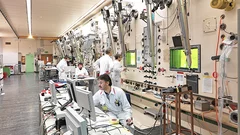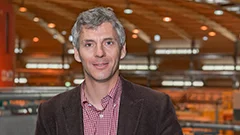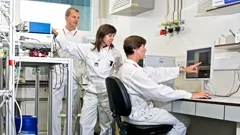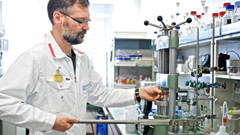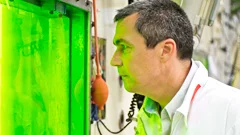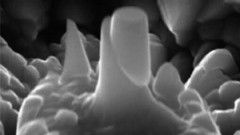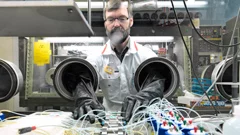News & Scientific Highlights
The hotlab research facility
Start of the public examination period for renewed authorization to operate the research facility hotlab at the Paul Scherrer Institute PSIThe hotlab at the Paul Scherrer Institute PSI is a facility, unique in Switzerland, where researchers study highly radioactive materials in specially shielded chambers called hot cells. It serves the needs of applied materials research on highly radioactive samples from core structural components and fuel rods from nuclear power plants, research reactors, and the PSI radiation facilities. Through its operation of the hotlab, the Paul Scherrer Institute also contributes to the safety of the nuclear power plants in Switzerland. Around thirty staff members attend to the hotlab's safety technology and analysis infrastructure.
Hydrogen: a Trojan horse in fuel-rod cladding tubes
In nuclear reactors, water is dissociated at the surface of the hot fuel elements, thereby producing hydrogen. This hydrogen can penetrate the fuel cladding surrounding the actual fuel and weaken it mechanically. Researchers from the Paul Scherrer Institute (PSI) have been using neutrons and synchrotron radiation to study how the hydrogen gets into the cladding tube and what impact it can have once inside.
Well-rounded concept for less nuclear waste
The idea of producing fuel for nuclear power stations in form of a package of spheres instead of today’s customary pellets was already born back in the 1960s. There was promise of a subsequent simplification of fuel production and a considerable reduction in the amount of radioactive waste both in the production of the fuel itself and after its use in a nuclear power station. However, the spherical fuel was never implemented as the fast reactors for which it was conceived were never built at a large scale. The Paul Scherrer Institute (PSI) has also been involved in the research on spherical fuel in the past. Now several projects partly funded by the EU are currently underway at the PSI again to refine the production of fuel spheres further. This form of fuel could either be used in special plants to reduce waste or in fast generation IV reactors, which in a closed cycle also produce less long-lived waste.
How radionuclides escape through rock: insights for a geological waste storage site
How do radioactive substances move through the host rock in a deep repository for nuclear waste? Researchers from the Diffusion Processes Group in the Laboratory of Waste Management at the Paul Scherrer Institute (PSI) have been investigating. The transport properties of negatively charged radionuclides, which are repelled by the negatively charged surfaces of clay minerals and thus hardly adhere to the rock, are well known. An EU project in which the PSI is also involved is now yielding similar insights into positively charged and therefore highly adherent radionuclides.
Knowledge for tomorrow from "hot cells"
The manipulation and examination of irradiated and therefore radioactive objects, be they from nuclear power stations or research facilities, requires strict safety measures. Tests may only be conducted in so-called hot cells, where the radioactivity is hermetically enclosed and shielded behind concrete and lead walls up to 1 metre thick. In the hot cells of the PSI hot lab, the burnt-off fuel rods from the Swiss nuclear power stations are studied from a materials science perspective. The insights gained help nuclear power station operators to optimise the efficiency and safety of their plants. Besides this service, the hot lab is involved in several international research projects.
Reliable materials for nuclear reactors
Materials used in nuclear power plants are subjected to extreme conditions. The safety standards for the selection, deployment and monitoring of these materials are extremely high. At PSI, the long-term behaviour of power plant components is being studied. Hence researchers investigate the impact of stress-corrosion cracking in materials, or the effects of strong radioactive radiation on their durability.
Safe repositories for radioactive waste - a study of specifically Swiss conditions
Radioactive waste from nuclear power plants, as well as from medical applications, industry and research, has to be isolated from the environment, particularly the habitat of humans, for a very long time. Specialists at PSI have been concerned with the safety issues surrounding safety certification for geological repositories for many years. Research at PSI focusses primarily on the physico-chemical processes inside such storage systems. The aim is to create a realistic description of the risks associated with storage of radioactive waste.
